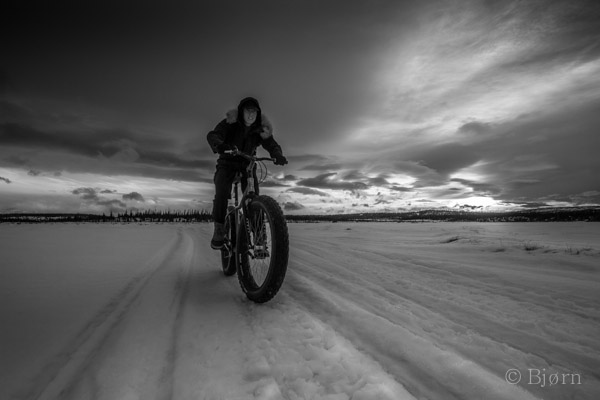For more than 100 years people have been doing amazing things with bicycles, in Alaska. In 1898 a handful of hardy souls rode over 1,000 miles from Dawson to Nome — well before cars, trains or even roads.
Not long after the invention of the mountain bike, Alaskan adventurers began exploring winter trails. In 1989 four men rode the entire Iditarod Trail. That expedition and the human powered race ‘Iditasport’ inspired the quest to design a better-suited bicycle — with more ‘floatation’. Back yard tinkerers, hobbyists and a few bike shops began experimenting with bicycle, wheel and tire designs through the 90s.
Fat is a relative term. When All Weather Sports in Fairbanks came out with the Snowcat, a 44mm wide rim, they looked, to many, to be clownishly large and suited only to the winter ‘crazies’. And yet, the push for more floatation continued. The Achilles Heel was the tire. Small businesses or hobbyists could not afford designing or manufacturing suitably wide rubber.
The first commercially available fatbike was the ‘Wildfire’. Mark Gronewald of Palmer Alaska teamed up with Texan, Ray Molino and together they designed a bike around 80mm wide rims and a 4” tire. The Wildfire was the vanguard of what we now identify as a fatbike. Gronewwald coined the term ‘fatbike’ and everyone who rides one owes a debt of gratitude to this Alaskan visionary.
Increased interest and a persistent pressure from Alaskans finally convinced Surly Bikes to jump into this fringe market. The Surly Pugsley was the first affordable snow-bike with 4” tires. Every year since has seen an almost exponential growth in design and appeal — similar to the mountain bike in the 80s.
In a state full of ‘not road or trails’, the fatbike is an obvious choice for year round adventurers and cyclists. From beaches, to alpine tundra, gravel river bars, snow trails and spring crust — the fatbike works.
In less than a decade, sub-genera’s of fat tire bikers have evolved. Some strip their bikes down to the bare bones and take them on long overland bike-packing adventures; while others employ suspension and hydraulic disc brakes, using them like cross-country/free ride bikes. Many use them as a logical choice for year round commuting in communities that experience extreme inclement weather. There is no wrong answer.
Homer Cycling Club celebrates bicycles and people who ride them. Due to our beaches and great winter trails, Homer is an amazing place to own and ride a fatbike.
Each winter for the past two years Homer Cycling Club hosts Big Fat Bike Festival and this year will be no exception. The dates always fluctuate around the end of February based on two factors — not conflicting with Winter Carnival and the best daytime tides. This winter, Big Fat Bike Festival will land on Friday the 21st through Sunday the 23rd.
Events will include beach bonfires, group ride from Anchor Point to Homer, burger and brew, silent and live auction, obstacle course and much more.
Weather you are a seasoned rider or first timer, Big Fat Bike Festival is a great time to come out and experience this uniquely Alaskan pursuit.
Hope to see you there.
Bjørn Olson
Homer Cycling Club Board Member


